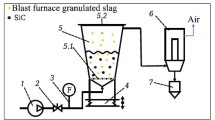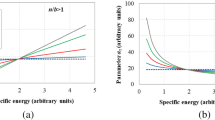Abstract
Investigations were performed on fine grinding of bituminous coal in a laboratory-scale pulverizer. The results indicated that the breakage behavior at relatively coarse sizes (i.e., greater than about 20 µm) is essentially “normal.” However, at fine sizes (i.e., less than about 10 µm), there is clear evidence of reagglomeration. A simplified population-balance model for simultaneous growth and breakage is formulated. Breakage rates and breakage distributions were assumed to follow the patterns typically observed in simple grinding systems. It is recognized, however, that solid particles and agglomerates may exhibit different breakage behaviors. Agglomeration rates are assumed to be determined by contact probability, i.e., by the relative numbers of interacting particles. Based on comparisons between model simulations and experimental data, it appears that agglomerate rebreakage rates and fragment size distributions are quite different from those for solid particles. The result is that product size passes through a minimum and then increases with time as agglomeration begins to dominate.
Similar content being viewed by others
References
Austin, L.G., and Luckie, P.T., 1971/72, “Methods for determination of breakage distribution parameters,” Powder Technology, Vol. 5, pp. 215–222.
Austin, L.G., and Bagga, P., 1981, “An analysis of fine dry grinding in ball mills,” Powder Technology, Vol. 28, pp. 83–90.
Austin, L.G., Klimpel, R.R., and Luckie, P.T., 1984, Process Engineering of Size Reduction: Ball Milling, SME, AIME, Littleton, CO.
Berg, T.G.O., and Avis, L.E., 1970/71, “Exploratory experiments on kinetics of comminution,” Powder Technology, Vol. 4, pp. 27–31.
Cho, H., Waters, M.A., and Hogg, R., 1994, “Investigation of the grind limit in stirred-media milling,” 8th European Symposium on Comminution, Stockholm, Sweden, pp. 675–685.
Ghigi, G. and Rabottino, L., 1967, “Experiments on Cement Clinker Grinding with Additives,” Dechema Monograph, Vol. 57, pp. 427–448.
Herbst, J.A., and Fuerstenau, D.W., 1968, “The zero order production of true sizes on comminution and its implications in simulation,” Transactions, SME/AIME, Vol. 241, pp. 538–549.
Ho, T., and Hersey, J.A., 1979, “Granulation using the agglomerative phase of comminution,” Powder Technology, Vol. 23, pp. 191–195.
Hogg, R., Maffei, A.C., and Ray, D.T., 1990, “Modeling of Flocculation Processes for Dewatering System Control,” Control90. Min. & Met. Proc., R.K. Rajamani and J.A. Herbst, eds., SME, Littleton, CO.
Hogg, R., 1992, “Agglomeration models for process design and control,” Powder Technology, Vol. 69, pp. 69–76.
Hukki, R.T., and Reddy, I.G., 1967, “The relationship between net energy input and fines in comminution,” Dechema-Monograph, Vol. 57, pp. 313–339.
Jimbo, G., Zhao, Q.Q., Yokoyama, T., and Taniyama, Y., 1990, “The grinding limit and the negative grinding phenomenon,” Proceedings. 2nd World Congress on Particle Technology, Kyoto, Japan, pp. 305–313.
Kolacz, J., and Sandvik, K.L., May 1994, “Ultrafine grinding in air-swept ball mill circuit,” 8th European Symposium on Comminution, Stockholm, Sweden, pp. 367–377.
Krycer, I., 1981, “Grinding and granulation in a vibratory ball mill,” Powder Technology, Vol. 28, pp. 91–95.
Kuwahara, Y., Suzuki, K., and Ishizuka, T., 1990, “Ultra-fine grinding and contamination of powder on vibration milling,” Proceedings, 2nd World Congress Particle on Technology, Kyoto, Japan, pp. 280–287.
Opoczky, L., 1977, “Fine grinding and agglomeration of silicates,” Powder Technology, Vol. 17, pp. 1–7.
Opoczky, L., and Farnady, F., 1984, “Fine grinding and states of equilibrium,” Powder Technology, Vol. 39, pp. 107–115.
Shah, I., and Austin, L.G., 1983, “Breakage rates and size distributions in dry ball milling for fine sizes,” in Ultrafine Grinding and Separation of Industrial Minerals, SME, AIME, Littleton, CO.
Schonert, K., 1990, “Physical and technical aspects of very fine grinding,” Proceedings, 2nd World Congress on Particle Technology, Kyoto, Japan, pp. 257–271.
Strazisar, J., and Runove, F., May 1994, “Kinetics of comminution in micro- and Submicrometer Ranges,” 8th European Symposium on Comminution, Stockholm, Sweden, pp. 751–761.
Wen, S.B., and Chen, C.K., 1988, “Size reduction of magnetite sand to nanometer powder in a laboratory vibration mill,” Powder Technology, Vol. 55, pp. 11–17.
Zhao, Q.Q., Kaneko, K., and Kawashima, M., 1990, “Development of continuous planetary ball mill for ultrafine grinding,” Proceedings, 2nd World Congress on Particle Technology, Kyoto, Japan, pp. 564–571.
Author information
Authors and Affiliations
Additional information
SME preprint 96-171, SME Annual Meeting, March 11–14, 1996, Phoenix, AZ.
M&MP paper 96-632. Discussion of this peer-reviewed and approved paper is invited and must be submitted to SME prior to Aug. 31, 1997.
Rights and permissions
About this article
Cite this article
Kaya, E., Cho, H. & Hogg, R. Reagglomeration phenomena in fine dry grinding of coal. Mining, Metallurgy & Exploration 14, 37–42 (1997). https://doi.org/10.1007/BF03402757
Received:
Revised:
Published:
Issue Date:
DOI: https://doi.org/10.1007/BF03402757




